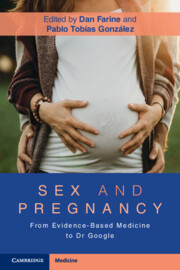Book contents
- Sex and Pregnancy
- Sex and Pregnancy
- Copyright page
- Dedication
- Contents
- Contributors
- Preface
- Section 1 General Issues
- Section 2 Specific Issues
- Chapter 9 Sex and Assisted Reproductive Technologies
- Chapter 10 The Male Partner’s Perspective
- Chapter 11 Sex in the First Trimester
- Chapter 12 Sex in the Second and Third Trimesters
- Chapter 13 Sex with Bleeding in the First Trimester
- Chapter 14 Sex with Bleeding in the Second and Third Trimesters
- Chapter 15 Short Cervix and Sex
- Chapter 16 Preterm Birth and Sex
- Chapter 17 Multiple Pregnancies and Sex
- Chapter 18 Special Pregnancies and Sex
- Chapter 19 Air Embolism Related to Sex in Pregnancy and the Postpartum
- Chapter 20 Pelvic and Ovarian Masses during Pregnancy
- Chapter 21 Sexually Transmitted Infections and Pregnancy
- Chapter 22 Sex for Induction of Labor
- Chapter 23 Nipple Stimulation during Pregnancy
- Chapter 24 Sex during the Postpartum
- Chapter 25 Sex after Pelvic Floor Injuries
- Chapter 26 Miscarriages, Spontaneous Abortions, Stillbirths, and Sex
- Index
- References
Chapter 11 - Sex in the First Trimester
from Section 2 - Specific Issues
Published online by Cambridge University Press: 09 November 2022
- Sex and Pregnancy
- Sex and Pregnancy
- Copyright page
- Dedication
- Contents
- Contributors
- Preface
- Section 1 General Issues
- Section 2 Specific Issues
- Chapter 9 Sex and Assisted Reproductive Technologies
- Chapter 10 The Male Partner’s Perspective
- Chapter 11 Sex in the First Trimester
- Chapter 12 Sex in the Second and Third Trimesters
- Chapter 13 Sex with Bleeding in the First Trimester
- Chapter 14 Sex with Bleeding in the Second and Third Trimesters
- Chapter 15 Short Cervix and Sex
- Chapter 16 Preterm Birth and Sex
- Chapter 17 Multiple Pregnancies and Sex
- Chapter 18 Special Pregnancies and Sex
- Chapter 19 Air Embolism Related to Sex in Pregnancy and the Postpartum
- Chapter 20 Pelvic and Ovarian Masses during Pregnancy
- Chapter 21 Sexually Transmitted Infections and Pregnancy
- Chapter 22 Sex for Induction of Labor
- Chapter 23 Nipple Stimulation during Pregnancy
- Chapter 24 Sex during the Postpartum
- Chapter 25 Sex after Pelvic Floor Injuries
- Chapter 26 Miscarriages, Spontaneous Abortions, Stillbirths, and Sex
- Index
- References
Summary
The first trimester of pregnancy covers a major transition period for pregnant individuals and their partners. Sexual satisfaction, including in pregnancy, is an important facet of a fulfilling relationship. The frequency of sexual activity decreases during the first trimester and is accompanied by increased sexual dysfunction, particularly once the pregnancy is identified. This may be secondary to physical factors such as fatigue and nausea and vomiting as well as a fear of miscarriage or harm to the pregnancy. Sexual activity in the first trimester has not been demonstrated to result in miscarriage, adverse obstetric outcomes, or fetal harm. Vaginal bleeding may be associated with an increased risk of miscarriage and therefore caution is advisable for vaginal intercourse in these cases. Obstetric care providers can support couples in early pregnancy by including discussions of the safety of sexual activity, expectations during pregnancy, and alternative mechanisms of intimacy as part of routine pregnancy care.
- Type
- Chapter
- Information
- Sex and PregnancyFrom Evidence-Based Medicine to Dr Google, pp. 70 - 76Publisher: Cambridge University PressPrint publication year: 2022

